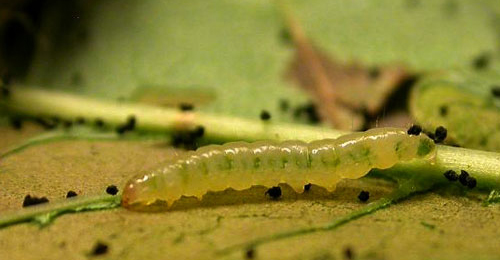|
||||||
|
Caloptilia
cuculipennella (Hübner, 1796) Feathered Slender Tinea
cuculipennella
Hübner, 1796. Samml. Europ. Schmett.
8 (Tin.): 6A fig. 1, 6B fig. 2 |
|||||||||||||||||||||||||||||||||||||||||||||||||||||||||||||||||||||||||||||||||||||||||||||||||||||||||||||||||||||||||||||||||||||||||||||||||||||||||
|
Leaf-miner: Larva solitary in an elongate upper-surface epidermal (thence silvery) mine. Frass initially in a rust-coloured central line. Later, when the mine starts to contract and the leaf folds over the mine, the frass is black and concentrated in a corner of the mine. At this point the larva leaves the mine, and starts living freely in a downwards rolled leaflet (Bladmineerders van Europa). The mine can be distinguished from that of G.syringella on the same plant as it is a silver colour whereas that of G.syringella is brownish (British leafminers). Larva: The larvae of moths have a head capsule and chewing mouthparts with opposable mandibles (see video of a gracillarid larva feeding), six thoracic legs and abdominal legs (see examples). Emmet, Watkins and Wilson (1985a) write that the larva has a black spot laterally on head and prothorax; that does not match with the photo above (Bladmineerders van Europa).
Pupa: The pupae of moths have visible head appendages, wings and legs which lie in sheaths (see examples). Adult: The adult is illustrated in UKMoths. The species is included in mothdissection.co.uk. Hosts in Great Britain and Ireland:
Hosts elsewhere:
Time of year - larvae: July-September (British leafminers). Time of year - adults: Currently unknown. Distribution in Great Britain and Ireland: Britain & Ireland (Fauna Europaea) including Denbighshire, Derbyshire, Dorset, Durham, East Cornwall, East Kent, East Ross, Glamorgan, Hertfordshire, North Somerset, Shropshire, South Northumberland, Stafford, West Cornwall, West Gloucestershire, West Norfolk and Westmorland (NBN Atlas). See also British leafminers distribution map. Also recorded from the Republic of Ireland. See also Ireland's National Biodiversity Data Centre Map). Distribution elsewhere: Widespread in continental Europe including Albania, Austria, Belgium, Czech Republic, Danish mainland, Estonia, Finland, French mainland, Germany, Hungary, Italian mainland, Latvia, Norwegian mainland, Poland, Romania, Russia - Central, Northwest and South, Sardinia, Slovakia, Sweden, Switzerland, The Netherlands, Ukraine and Yugoslavia (Fauna Europaea). NBN Atlas links to known host species:
British and Irish Parasitoids in Britain and elsewhere:
|
|||||||||||||||||||||||||||||||||||||||||||||||||||||||||||||||||||||||||||||||||||||||||||||||||||||||||||||||||||||||||||||||||||||||||||||||||||||||||
| Last updated 11-Jul-2019 Brian Pitkin | ||

